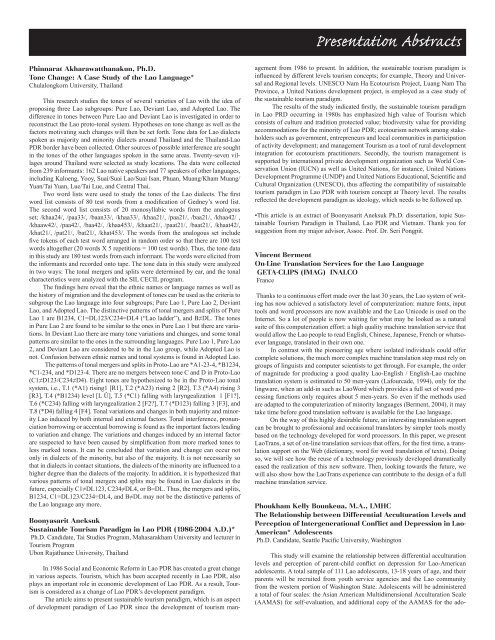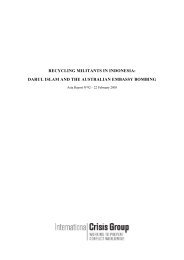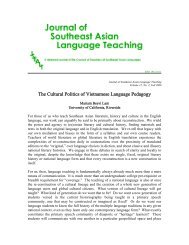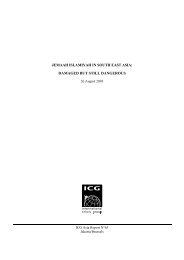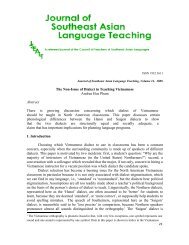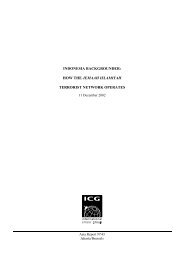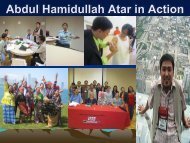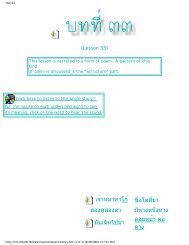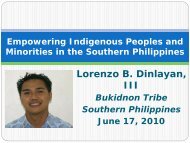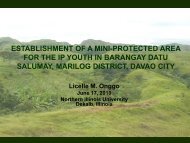Introduction - SEAsite - Northern Illinois University
Introduction - SEAsite - Northern Illinois University
Introduction - SEAsite - Northern Illinois University
You also want an ePaper? Increase the reach of your titles
YUMPU automatically turns print PDFs into web optimized ePapers that Google loves.
Prentation Abstracts<br />
Phinnarat Akharawatthanakun, Ph.D.<br />
Tone Change: A Case Study of the Lao Language*<br />
Chulalongkorn <strong>University</strong>, Thailand<br />
This research studies the tones of several varieties of Lao with the idea of<br />
proposing three Lao subgroups: Pure Lao, Deviant Lao, and Adopted Lao. The<br />
difference in tones between Pure Lao and Deviant Lao is investigated in order to<br />
reconstruct the Lao proto-tonal system. Hypotheses on tone change as well as the<br />
factors motivating such changes will then be set forth. Tone data for Lao dialects<br />
spoken as majority and minority dialects around Thailand and the Thailand-Lao<br />
PDR border have been collected. Other sources of possible interference are sought<br />
in the tones of the other languages spoken in the same areas. Twenty-seven villages<br />
around Thailand were selected as study locations. The data were collected<br />
from 239 informants: 162 Lao native speakers and 77 speakers of other languages,<br />
including Kaloeng, Yooy, Suai/Suai Lao/Suai Isan, Phuan, Muang/Kham Muang/<br />
Yuan/Tai Yuan, Lue/Tai Lue, and Central Thai.<br />
Two word lists were used to study the tones of the Lao dialects. The first<br />
word list consists of 80 test words from a modification of Gedney’s word list.<br />
The second word list consists of 20 monosyllabic words from the analogous<br />
set; /khaa24/, /paa33/, /baan33/, /khaa33/, /khaa21/, /paa21/, /baa21/, /khaa42/ ,<br />
/khaaw42/, /paa42/, /baa42/, /khaa453/, /khaat21/, /paat21/, /baat21/, /khaat42/,<br />
/khat21/, /pat21/, /bat21/, /khat453/. The words from the analogous set include<br />
five tokens of each test word arranged in random order so that there are 100 test<br />
words altogether (20 words X 5 repetitions = 100 test words). Thus, the tone data<br />
in this study are 180 test words from each informant. The words were elicited from<br />
the informants and recorded onto tape. The tone data in this study were analyzed<br />
in two ways: The tonal mergers and splits were determined by ear, and the tonal<br />
characteristics were analyzed with the SIL CECIL program.<br />
The findings here reveal that the ethnic names or language names as well as<br />
the history of migration and the development of tones can be used as the criteria to<br />
subgroup the Lao language into four subgroups; Pure Lao 1, Pure Lao 2, Deviant<br />
Lao, and Adopted Lao. The distinctive patterns of tonal mergers and splits of Pure<br />
Lao 1 are B1234, C1=DL123/C234=DL4 (“Lao ladder”), and B≠DL. The tones<br />
in Pure Lao 2 are found to be similar to the ones in Pure Lao 1 but there are variations.<br />
In Deviant Lao there are many tone variations and changes, and some tonal<br />
patterns are similar to the ones in the surrounding languages. Pure Lao 1, Pure Lao<br />
2, and Deviant Lao are considered to be in the Lao group, while Adopted Lao is<br />
not. Confusion between ethnic names and tonal systems is found in Adopted Lao.<br />
The patterns of tonal mergers and splits in Proto-Lao are *A1-23-4, *B1234,<br />
*C1-234, and *D123-4. There are no mergers between tone C and D in Proto-Lao<br />
(C1≠D123/C234≠D4). Eight tones are hypothesized to be in the Proto-Lao tonal<br />
system, i.e., T.1 (*A1) rising1 [R1], T.2 (*A23) rising 2 [R2], T.3 (*A4) rising 3<br />
[R3], T.4 (*B1234) level [L Û], T.5 (*C1) falling with laryngealization 1 [F1?],<br />
T.6 (*C234) falling with laryngealization 2 [F2?], T.7 (*D123) falling 3 [F3], and<br />
T.8 (*D4) falling 4 [F4]. Tonal variations and changes in both majority and minority<br />
Lao induced by both internal and external factors. Tonal interference, pronunciation<br />
borrowing or accentual borrowing is found as the important factors leading<br />
to variation and change. The variations and changes induced by an internal factor<br />
are suspected to have been caused by simplification from more marked tones to<br />
less marked tones. It can be concluded that variation and change can occur not<br />
only in dialects of the minority, but also of the majority. It is not necessarily so<br />
that in dialects in contact situations, the dialects of the minority are influenced to a<br />
higher degree than the dialects of the majority. In addition, it is hypothesized that<br />
various patterns of tonal mergers and splits may be found in Lao dialects in the<br />
future, especially C1≠DL123, C234≠DL4, or B=DL. Thus, the mergers and splits,<br />
B1234, C1=DL123/C234=DL4, and B≠DL may not be the distinctive patterns of<br />
the Lao language any more.<br />
Boonyasarit Aneksuk<br />
Sustainable Tourism Paradigm in Lao PDR (1986-2004 A.D.)*<br />
Ph.D. Candidate, Tai Studies Program, Mahasarakham <strong>University</strong> and lecturer in<br />
Tourism Program<br />
Ubon Rajathanee <strong>University</strong>, Thailand<br />
In 1986 Social and Economic Reform in Lao PDR has created a great change<br />
in various aspects. Tourism, which has been accepted recently in Lao PDR, also<br />
plays an important role in economic development of Lao PDR. As a result, Tourism<br />
is considered as a change of Lao PDR’s development paradigm.<br />
The article aims to present sustainable tourism paradigm, which is an aspect<br />
of development paradigm of Lao PDR since the development of tourism management<br />
from 1986 to present. In addition, the sustainable tourism paradigm is<br />
influenced by different levels tourism concepts; for example, Theory and Universal<br />
and Regional levels. UNESCO Nam Ha Ecotourism Project, Luang Nam Tha<br />
Province, a United Nations development project, is employed as a case study of<br />
the sustainable tourism paradigm.<br />
The results of the study indicated firstly, the sustainable tourism paradigm<br />
in Lao PRD occurring in 1980s has emphasized high value of Tourism which<br />
consists of culture and tradition protected value; biodiversity value for providing<br />
accommodations for the minority of Lao PDR; ecotourism network among stakeholders<br />
such as government, entrepreneurs and local communities in participation<br />
of activity development; and management Tourism as a tool of rural development<br />
integration for ecotourism practitioners. Secondly, the tourism management is<br />
supported by international private development organization such as World Conservation<br />
Union (IUCN) as well as United Nations, for instance, United Nations<br />
Development Programme (UNDP) and United Nations Educational, Scientific and<br />
Cultural Organization (UNESCO), thus affecting the compatibility of sustainable<br />
tourism paradigm in Lao PDR with tourism concept at Theory level. The results<br />
reflected the development paradigm as ideology, which needs to be followed up.<br />
•This article is an extract of Boonyasarit Aneksuk Ph.D. dissertation, topic Sustainable<br />
Tourism Paradigm in Thailand, Lao PDR and Vietnam. Thank you for<br />
suggestion from my major advisor, Assoc. Prof. Dr. Seri Pongpit.<br />
Vincent Berment<br />
On-Line Translation Services for the Lao Language<br />
GETA-CLIPS (IMAG) INALCO<br />
France<br />
Thanks to a continuous effort made over the last 30 years, the Lao system of writing<br />
has now achieved a satisfactory level of computerization: mature fonts, input<br />
tools and word processors are now available and the Lao Unicode is used on the<br />
Internet. So a lot of people is now waiting for what may be looked as a natural<br />
suite of this computerization effort: a high quality machine translation service that<br />
would allow the Lao people to read English, Chinese, Japanese, French or whatsoever<br />
language, translated in their own one.<br />
In contrast with the pioneering age where isolated individuals could offer<br />
complete solutions, the much more complex machine translation step must rely on<br />
groups of linguists and computer scientists to get through. For example, the order<br />
of magnitude for producing a good quality Lao-English / English-Lao machine<br />
translation system is estimated to 50 men-years (Lafourcade, 1994), only for the<br />
lingware, when an add-in such as LaoWord which provides a full set of word processing<br />
functions only requires about 5 men-years. So even if the methods used<br />
are adapted to the computerization of minority languages (Berment, 2004), it may<br />
take time before good translation software is available for the Lao language.<br />
On the way of this highly desirable future, an interesting translation support<br />
can be brought to professional and occasional translators by simpler tools mostly<br />
based on the technology developed for word processors. In this paper, we present<br />
LaoTrans, a set of on-line translation services that offers, for the first time, a translation<br />
support on the Web (dictionary, word for word translation of texts). Doing<br />
so, we will see how the reuse of a technology previously developed dramatically<br />
eased the realization of this new software. Then, looking towards the future, we<br />
will also show how the LaoTrans experience can contribute to the design of a full<br />
machine translation service.<br />
Phoukham Kelly Bounkeua, M.A., LMHC<br />
The Relationship between Differential Acculturation Levels and<br />
Perception of Intergenerational Conflict and Depression in Lao-<br />
American* Adolescents<br />
Ph.D. Candidate, Seattle Pacific <strong>University</strong>, Washington<br />
This study will examine the relationship between differential acculturation<br />
levels and perception of parent-child conflict on depression for Lao-American<br />
adolescents. A total sample of 111 Lao adolescents, 13-18 years of age, and their<br />
parents will be recruited from youth service agencies and the Lao community<br />
from the western portion of Washington State. Adolescents will be administered<br />
a total of four scales: the Asian American Multidimensional Acculturation Scale<br />
(AAMAS) for self-evaluation, and additional copy of the AAMAS for the ado-


